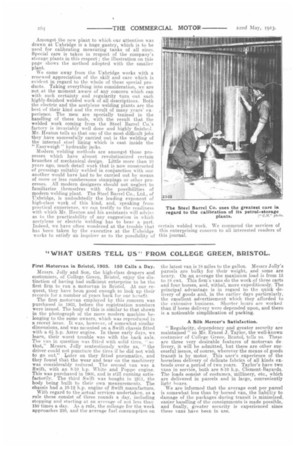"WHAT USERS TELL US" FROM COLLEGE GREEN, BRISTOL.
Page 24

If you've noticed an error in this article please click here to report it so we can fix it.
First Motorvan in Bristol, 1905. 150 Calls a Day.
Messrs. Jolly and Son, the high-class drapers and costumiers, of College Green, Bristol, enjoy the distinction of having had sufficient enterprise to be the first firm to run a motorvan in Bristol. At our request, they have been good enough to look up their records for a number of years back for our benefit.
The first motorvan employed by this concern was purchased in 1903, before the registration numbers were issued. The body of this is similar to that shown in the photograph of the more modern machine belonging to the same owners, which was reproduced in a recent issue. It was, however, of somewhat similar dimensions, and was mounted on a Swift chassis fitted with a 6i h.p. Aster engine. In those early days, we learn, their worst trouble was with the back axle. The van in question was fitted with solid tires, •• so that," Messrs. Jolly sententiously write us, " the driver could not puncture the tires if he did not wish to go out." Later on they fitted pneumatics, and they found that the wear and tear on the machinery was considerably reduced. The second van was a Swift, with an 8-10 h.p. White and Poppe engine. This was purchased in 1906, and is still running satisfactorily. The third Swift was bought in 1,011, the body being built to their own measurements. The chassis had a. 10-12 h.p. engine of Swift manufacture. With regard to the actual services undertaken, as a rule these consist of three rounds a day, including stopping and starting at an average of not less than 150 times a day. As a rule, the mileage for the week approaches 20, and the average fuel consumption on the latest van is 18 miles to the gallon. Messrs Jolly's parcels are bulky for their weight, and some are heavy. On an average the maximum load is from 15 to 18 cwt. This firm's vans do the work of three carts and four horses, and, withal, more expeditiously. The principal advantage is in regard to the quick delivery of goods and, in the earlier days particularly, the excellent advertisement which they afforded to the extensive business. Shorter hours are worked than if horse delivery were depended upon, and there is a noticeable simplification of packing.
A Silk Mercer's Satisfaction.
" Regularity, dependency and greater security are maintained" so Mr. Ernest J. Taylor, the well-known costumier of College Green, Bristol, tells us. These are three very desirable features of motorvan de livery, it will be admitted, but there are other successful issues, of course, wherever the means of goods transit is by motor. This user's experience of the horseless delivery of delicate fabrics of all kinds extends over a period of two years. Taylor's have two vans in service, both are 8-10 h.p. Clement-Bayards. The loads consist of costumes, millinery, etc., which are delivered in parcels and in large, conveniently light boxes.
We are informed that the average cost per parcel is somewhat less than by horsed van, the liability to damage of the packages during transit is minimized, easier handling of the consignments is made possible, and finally, greater security is experienced since these vans have been in use.




























